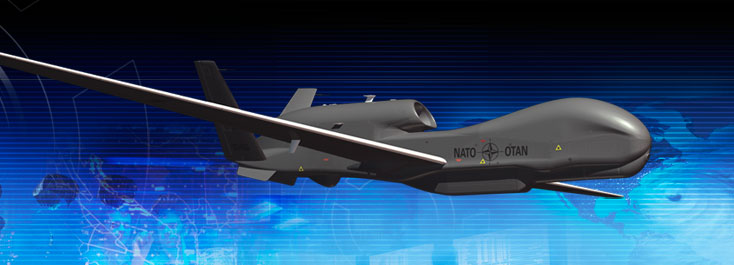 In 2017, NATO is scheduled to have in place its first-ever Alliance asset for collecting strategic intelligence: the Alliance Ground Surveillance system. The fleet of five Global Hawk remotely piloted aircraft will carry a sophisticated radar capable of monitoring the situation on the ground from high overhead, including the movement of objects of interest such as military vehicles.
In 2017, NATO is scheduled to have in place its first-ever Alliance asset for collecting strategic intelligence: the Alliance Ground Surveillance system. The fleet of five Global Hawk remotely piloted aircraft will carry a sophisticated radar capable of monitoring the situation on the ground from high overhead, including the movement of objects of interest such as military vehicles.
The Global Hawks will transmit synthetic aperture radar images—which look like photographs—and tracking data on the moving objects down to NATO intelligence analysts. These specially trained personnel will then create intelligence products for the Alliance’s political leadership and military commanders, down to the tactical level, quickly enough to be relevant. This information will provide insight into topics such as the position of combat forces, battle damage sustained by a target, or devastation caused by a natural disaster.
Alliance officials have said NATO’s operation to protect civilians in Libya in 2011 demonstrated the importance of this situational awareness. To date, NATO has had to rely on the national assets of its members, especially the United States, for this type of capability, making the AGS acquisition truly groundbreaking.
“AGS is indeed a kind of game changer,” said a NATO official during an interview at Alliance headquarters in Brussels, Belgium, in late June. “It changes the dynamic within the Alliance to have access to that kind of information.”
Half of NATO’s 28 members are procuring AGS: the United States, Bulgaria, Czech Republic, Denmark, Estonia, Germany, Italy, Latvia, Lithuania, Luxembourg, Norway, Romania, Slovakia, and Slovenia. Poland is poised to join this group, expected to formally become the 15th procuring nation before year’s end.
All Alliance members will contribute to AGS operations and support costs—or provide some “assistance in kind” in the case of Britain and France. Over its life cycle, AGS is expected to cost Alliance members some 2.2 billion euros in base year 2011 calculations.
Every member state will also have the opportunity to contribute its nationals to the force of some 600 military and civilian personnel who will operate and maintain AGS out of Sigonella air base on Sicily in Italy and run the training schoolhouse there. . . .
Sigonella, the AGS fleet’s beddown site, is already home to US Global Hawk operations. The Italian base will also host AGS’ main ground control element, imagery exploitation center, and the training schoolhouse for the Global Hawk pilots, sensor operators, and the imagery analysts.
“We [will operate differently] from the US in the sense that everything is concentrated in a main operating base, so both launch and recovery and analytical capabilities are all concentrated, whereas in the US, there is a more decentralized system,” said the NATO official. . . .
The 600-member AGS force will comprise 522 military members and 78 civilians. . . .
NATO intends to operate the Global Hawks in “segregated airspace,” meaning separated from civil air traffic.
“Now these systems operate at 60,000 feet—well above civilian or commercial airliners—so if you manage to get it through a segregated airspace up to a certain altitude, then you deconflict with civilian traffic,” said the official. . . .
All 28 Alliance members will collectively fund the infrastructure, all but France will contribute to the satellite bandwidth costs, and all but Britain and France will provide money for operations and sustainment.
In place of funding AGS operations and sustainment, Britain and France intend to provide overhead SAR/GMTI contributions-in-kind to support NATO operations. The British have said they would make their Sentinel R.1 airborne standoff radar aircraft available, while the French have yet to commit to a platform.
France does not plan to contribute to the satellite communications costs because it wants to use its own bandwidth when it contributes in kind, said the official.
The British government has yet to resolve the fate of its Sentinel fleet. Identified for retirement in Britain’s 2010 defense white paper, the government is re-examining those plans after Sentinels demonstrated their worth in support of NATO operations in Libya in 2011 and, more recently, in the French military intervention in Mali.
Image: NATO AGS (graphic: Northrop Grumman)
